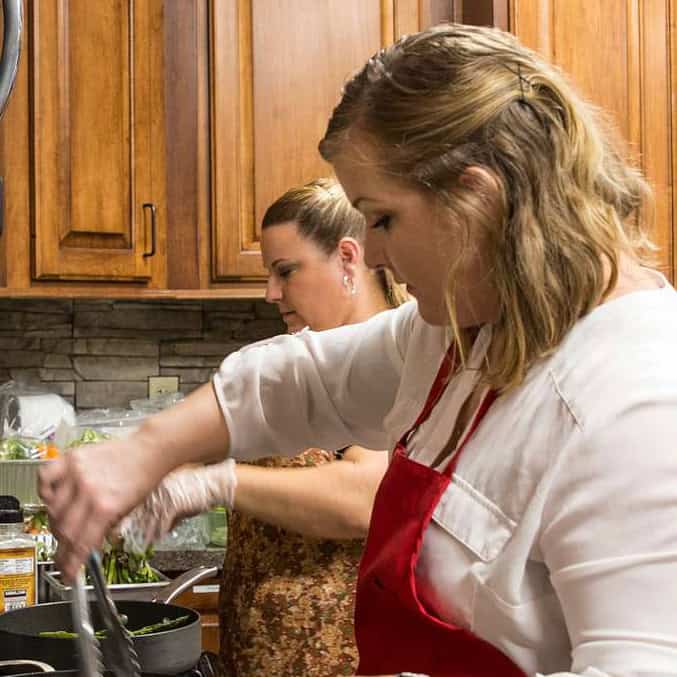Eating a healthy, fresh, plant-based diet doesn’t have to break the bank. While the produce aisle of the grocery store is known for its steep prices, leave room in your food budget for this essential part of your diet. Here are a few ways to stretch your dollar when it comes to eating at least five servings a day of fruits and vegetables.
1. Rescue Your Wilted Produce
Fruits and vegetables perish quickly in their raw form, leading to a shameful amount of food waste in homes. Learn a few storage tricks for prolonging the shelf life of raw produce. When the inevitable wilting does happen, all is not lost! Wilted leafy greens like spinach can be cooked down and refrigerated or frozen — ideal for omelets and quiches later on. Almost any vegetable past its freshness peak can be chopped up and thrown into a tasty soup. Salvage nearly-expired fruit by stewing, saucing, juicing, or tossing it in a smoothie. Google past-prime uses for foods before throwing away. You’ll save money by getting the most out of what’s already purchased.
2. Haggle at the Farmers’ Market
Farmers’ markets are not exactly associated with low prices, especially compared to grocery stores. Often you’ll pay a premium for buying from local, small-scale growers rather than mass-scale producers. However, one cost advantage of a farmers’ market is that prices are negotiable. If you go at the end of the day, vendors will cut good deals to get rid of their remnants. Point out bruises or other flaws. Also, shopping for fruits and vegetables seasonally during bumper harvest time also puts you in a position to haggle prices down.
3. Buy in Bulk, Process, and Freeze
If you have the freezer space for it, buying produce in bulk is a real money-saver. Whether it’s a steal of a deal at the farmers’ market or clearance pricing at the grocery store, take advantage of a temporarily low price and buy in bulk. This works great for fruits and vegetables at the height of their harvest season and therefore at their lowest prices all year. Use a fun Crisp Cooking tool to make the prep work a breeze! Clean, peel, slice, freeze, repeat.
4. Kick the Pickiness
People have strange hang-ups and prejudices about certain fruits and vegetables – even ones they’ve never tried. We’ve heard it all. Artichokes are too spiky and stand-offish. Brussel sprouts smell weird. Beets are too red and they stain everything on the plate. Eggplants are too spongy.
Maybe these biases about certain vegetables are leftover from childhood rebellion, or maybe people are just baffled by what to do with them in their raw form. Either way, by habitually overlooking produce items you dislike or aren’t familiar with, you could be missing out — both on nutrition and savings. Sales and discounts do not favor the picky. If eggplant is on Manager’s Special, now is the time to resolve your differences. Stock up and start experimenting with new, delicious ways to prepare it.
5. Buy Frozen and Canned
Buying bags of frozen fruits and veggies at the grocery store saves money. Frozen produce is generally less expensive per pound, and it retains a surprising amount of its nutritional value. If you’re buying vegetables that are bound to be cooked, or berries that are destined for the blender, frozen is the way to go.
Canned fruits and vegetables are the least expensive option, but they can also be a compromise as far as lost nutrients and unwanted sugar and sodium additives. Check the labels to see what’s been added, or better yet, take up home jarring and canning as a hobby. That way, you know exactly what went into it as you enjoy your preserved produce all year long.
6. Grow Your Own
Gardening isn’t free, and its start-up and maintenance costs may offset the savings on food bills, but it’s fun! Growing your own vegetables and herbs is a rewarding pastime. Whether you have just one sunny windowsill or an entire backyard of garden beds to work with, there’s an edible plant that will work for your space. To balance out your own crops, put your feelers out for others in your community who are growing food as well. If you harvest a surplus of something, see what kinds of bartering deals you can strike.
7. Go Foraging
As our ancient hunter-gatherer ancestors discovered, edible plants and fungi are all around us — you just have to look! Berries and mushrooms are two popular produce items to forage when the season is right. Most major cities have active foraging communities and events. Find an old pro to teach you the tricks, and bring the kids. Foraging makes for a fun, memorable and tasty family activity at a low cost.

Hello, I am Cristy. I love cooking but what I love most is keeping my kitchen tools and appliances top notch. I enjoy writing about everything I have learned around the kitchen. I believe that keeping your kitchen tools well cleaned and maintained produces the best dishes and drinks. Besides writing and cooking I enjoy traveling, camping, hiking and music.
